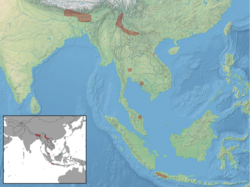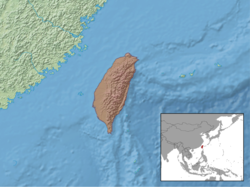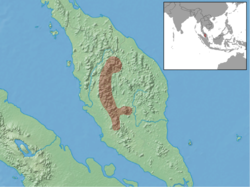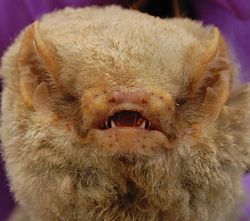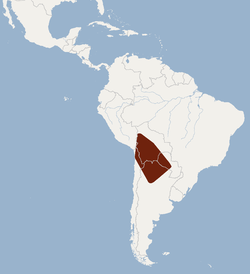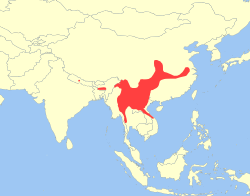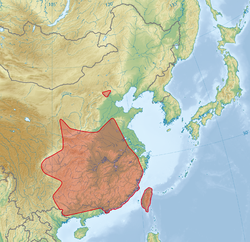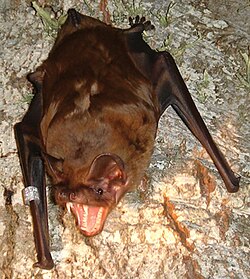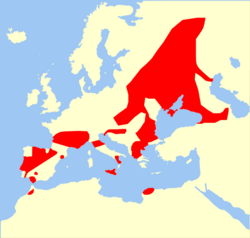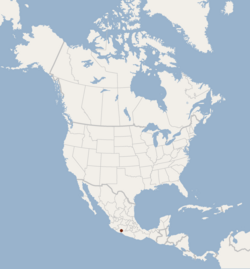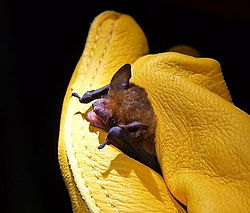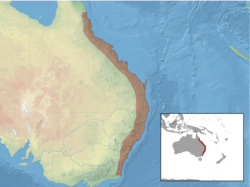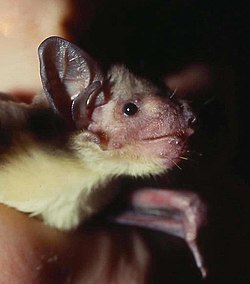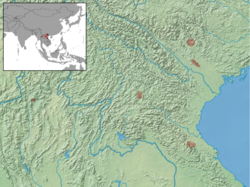| Common name | Scientific name and subspecies | Range | Size and ecology | IUCN status and estimated population |
|---|
| Aellen's pipistrelle
| P. inexspectatus
Aellen, 1959 | Western Africa | Size: About 5 cm (2 in), plus 3–4 cm (1–2 in) tail
3–4 cm (1–2 in) forearm length [187]
Habitat: Forest and savanna [188] | DD
Unknown  [188] [188]
|
|---|
| Angulate pipistrelle
| P. angulatus
Peters, 1880
- P. a. angulatus
- P. a. ponceleti
| Papua New Guinea and the Solomon Islands | Size: 3–5 cm (1–2 in), plus 2–5 cm (1–2 in) tail
3–4 cm (1–2 in) forearm length [187]
Habitat: Forest and caves [189] | LC
Unknown  [189] [189]
|
|---|
| Broad-headed serotine
| P. crassulus
(Thomas, 1904) | Central and western Africa | Size: 4–6 cm (2 in), plus 2–4 cm (1–2 in) tail
2–4 cm (1–2 in) forearm length [94]
Habitat: Forest [96] | LC
Unknown  [96] [96]
|
|---|
| Christmas Island pipistrelle†
| P. murrayi
(Andrews, 1900) | Christmas Island in Australia | Size: Unknown length
Habitat: Forest [190] | EX
0  [190] [190]
|
|---|
| Common pipistrelle  | P. pipistrellus
(Schreber, 1774)
- P. p. aladdin
- P. p. pipistrellus
| Europe, northern Africa, and Asia | Size: 3–6 cm (1–2 in), plus 2–4 cm (1–2 in) tail
2–4 cm (1–2 in) forearm length [75]
Habitat: Forest, shrubland, inland wetlands, and caves [191] | LC
Unknown  [191] [191]
|
|---|
| Dar es Salaam pipistrelle
| P. permixtus
Aellen, 1957 | Tanzania | Size: About 4 cm (2 in), plus about 3 cm (1 in) tail
about 3 cm (1 in) forearm length [187]
Habitat: Forest [192] | DD
Unknown  [192] [192]
|
|---|
| Dobson's pipistrelle
| P. grandidieri
(Dobson, 1876) | Western and eastern Africa | Size: 5–6 cm (2 in), plus 3–4 cm (1–2 in) tail
3–4 cm (1–2 in) forearm length [94]
Habitat: Forest, savanna, and inland wetlands [193] | DD
Unknown  [193] [193]
|
|---|
| Dusky pipistrelle
| P. hesperidus
(Temminck, 1840)
- P. h. fuscatus
- P. h. hesperidus
- P. h. subtilis
| Madagascar
 | Size: 4–6 cm (2 in), plus 2–5 cm (1–2 in) tail
2–4 cm (1–2 in) forearm length [187]
Habitat: Forest and savanna [194] | LC
Unknown  [194] [194]
|
|---|
| Endo's pipistrelle
| P. endoi
Imaizumi, 1959 | Japan
 | Size: 4–5 cm (2 in), plus 2–4 cm (1–2 in) tail
3–4 cm (1–2 in) forearm length [187]
Habitat: Forest [195] | NT
Unknown  [195] [195]
|
|---|
| Forest pipistrelle
| P. adamsi
Kitchener, Caputi, & Jones, 1986 | Northern Australia
 | Size: 3–5 cm (1–2 in), plus 2–4 cm (1–2 in) tail
2–4 cm (1–2 in) forearm length [187]
Habitat: Savanna and forest [196] | LC
Unknown  [196] [196]
|
|---|
| Greater Papuan pipistrelle
| P. collinus
Thomas, 1920 | Island of New Guinea | Size: 3–6 cm (1–2 in), plus 3–5 cm (1–2 in) tail
3–4 cm (1–2 in) forearm length [187]
Habitat: Forest [197] | LC
Unknown  [197] [197]
|
|---|
| Hanak's pipistrelle
| P. hanaki
Hulva & Benda, 2004 | Crete and Libya | Size: 4–5 cm (2 in), plus 3–4 cm (1–2 in) tail
3–4 cm (1–2 in) forearm length [187]
Habitat: Forest, shrubland, inland wetlands, and rocky areas [198] | VU
Unknown  [198] [198]
|
|---|
| Indian pipistrelle  | P. coromandra
Gray, 1838 | Southern and southeastern Asia
 | Size: 3–5 cm (1–2 in), plus 2–4 cm (1–2 in) tail
2–4 cm (1–2 in) forearm length [187]
Habitat: Forest and caves [199] | LC
Unknown  [199] [199]
|
|---|
| Japanese house bat 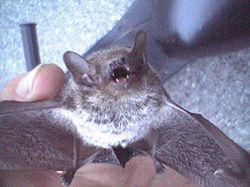 | P. abramus
(Temminck, 1840) | Eastern Asia
 | Size: 3–6 cm (1–2 in), plus 2–5 cm (1–2 in) tail
2–4 cm (1–2 in) forearm length [187]
Habitat: Forest, grassland, inland wetlands, and intertidal marine [200] | LC
Unknown  [200] [200]
|
|---|
| Java pipistrelle
| P. javanicus
Gray, 1838
- P. j. babu
- P. j. camortae
- P. j. javanicus
- P. j. meyeni
- P. j. peguensis
| Southern and southeastern Asia
 | Size: 4–6 cm (2 in), plus 2–4 cm (1–2 in) tail
2–4 cm (1–2 in) forearm length [187]
Habitat: Caves and forest [201] | LC
Unknown  [201] [201]
|
|---|
| Kelaart's pipistrelle
| P. ceylonicus
Kelaart, 1852
- P. c. borneanus
- P. c. ceylonicus
- P. c. indicus
- P. c. raptor
- P. c. shanorum
- P. c. subcanus
- P. c. tongfangensis
| Southern and southeastern Asia | Size: 4–7 cm (2–3 in), plus 3–5 cm (1–2 in) tail
3–5 cm (1–2 in) forearm length [187]
Habitat: Forest and caves [202] | LC
Unknown  [202] [202]
|
|---|
| Kuhl's pipistrelle 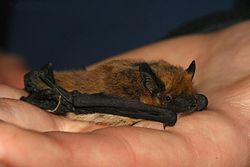 | P. kuhlii
Kuhl, 1817
- P. k. ikhwanius
- P. k. kuhlii
- P. k. lepidus
| Europe, western Asia, northern Africa, and Madagascar
 | Size: 4–6 cm (2 in), plus 3–5 cm (1–2 in) tail
3–4 cm (1–2 in) forearm length [187]
Habitat: Forest, shrubland, and grassland [203] | LC
Unknown  [203] [203]
|
|---|
| Least pipistrelle  | P. tenuis
(Temminck, 1840)
- P. t. mimus
- P. t. murrayi
- P. t. nitidus
- P. t. ponceleti
- P. t. portensis
- P. t. sewelanus
- P. t. subulidens
- P. t. tenuis
| Southern and southeastern Asia | Size: 3–5 cm (1–2 in), plus 2–4 cm (1–2 in) tail
2–4 cm (1–2 in) forearm length [187]
Habitat: Forest, shrubland, and grassland [204] | LC
Unknown  [204] [204]
|
|---|
| Lesser Papuan pipistrelle
| P. papuanus
Peters & Doria, 1881 | Indonesia and Papua New Guinea | Size: 3–5 cm (1–2 in), plus 2–4 cm (1–2 in) tail
2–4 cm (1–2 in) forearm length [187]
Habitat: Forest [205] | LC
Unknown  [205] [205]
|
|---|
| Madeira pipistrelle
| P. maderensis
Dobson, 1878 | Azores, Madeira Island and the Canary Islands
 | Size: 3–5 cm (1–2 in), plus 3–4 cm (1–2 in) tail
2–4 cm (1–2 in) forearm length [187]
Habitat: Forest and inland wetlands [206] | EN
2,000–2,500  [206] [206]
|
|---|
| Minahassa pipistrelle
| P. minahassae
von Meyer, 1899 | Indonesia | Size: About 6 cm (2 in), plus about 4 cm (2 in) tail
about 4 cm (2 in) forearm length [187]
Habitat: Unknown [207] | DD
Unknown  [207] [207]
|
|---|
| Mount Gargues pipistrelle
| P. aero
Heller, 1912 | Kenya and Ethiopia | Size: 4–5 cm (2 in), plus 3–4 cm (1–2 in) tail
3–4 cm (1–2 in) forearm length [187]
Habitat: Forest [208] | DD
Unknown  [208] [208]
|
|---|
| Mount Popa pipistrelle
| P. paterculus
Thomas, 1915
- P. p. paterculus
- P. p. yunnanensis
| Southern and southeastern Asia
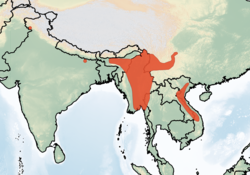 | Size: 4–5 cm (2 in), plus 3–4 cm (1–2 in) tail
2–4 cm (1–2 in) forearm length [187]
Habitat: Forest [209] | LC
Unknown  [209] [209]
|
|---|
| Narrow-winged pipistrelle  | P. stenopterus
Dobson, 1875 | Southeastern Asia
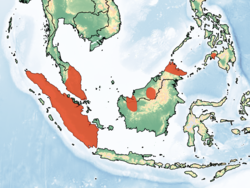 | Size: 5–7 cm (2–3 in), plus 3–6 cm (1–2 in) tail
3–5 cm (1–2 in) forearm length [187]
Habitat: Forest, shrubland, grassland, and inland wetlands [210] | LC
Unknown  [210] [210]
|
|---|
| Nathusius's pipistrelle 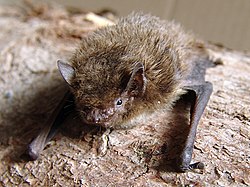 | P. nathusii
(Keyserling & Blasius, 1839) | Europe | Size: 4–6 cm (2 in), plus 3–4 cm (1–2 in) tail
3–4 cm (1–2 in) forearm length [187]
Habitat: Forest and inland wetlands [211] | LC
Unknown  [211] [211]
|
|---|
| Northern pipistrelle
| P. westralis
Koopman, 1984 | Northern Australia
 | Size: 3–5 cm (1–2 in), plus 2–4 cm (1–2 in) tail
2–4 cm (1–2 in) forearm length [187]
Habitat: Forest [212] | LC
Unknown  [212] [212]
|
|---|
| Racey's pipistrelle
| P. raceyi
Bates, Ratrimomanarivo, Harrison, & Goodman, 2006 | Madagascar
 | Size: 4–6 cm (2 in), plus 2–4 cm (1–2 in) tail
2–4 cm (1–2 in) forearm length [187]
Habitat: Forest [213] | DD
Unknown  [213] [213]
|
|---|
| Rüppell's bat  | P. rueppellii
J. B. Fischer, 1829
- P. r. coxi
- P. r. fuscipes
- P. r. pulcher
- P. r. rueppellii
- P. r. senegalensis
- P. r. vernayi
| Africa and southwestern Asia | Size: 4–6 cm (2 in), plus 2–5 cm (1–2 in) tail
2–4 cm (1–2 in) forearm length [75]
Habitat: Desert, shrubland, and savanna [214] | LC
Unknown  [214] [214]
|
|---|
| Rusty pipistrelle
| P. rusticus
(Tomes, 1861)
- P. r. marrensis
- P. r. rusticus
| Sub-Saharan Africa | Size: 4–5 cm (2 in), plus 1–4 cm (0.4–1.6 in) tail
2–4 cm (1–2 in) forearm length [187]
Habitat: Forest and savanna [215] | LC
Unknown  [215] [215]
|
|---|
| Soprano pipistrelle 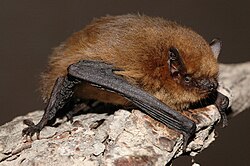 | P. pygmaeus
(Leach, 1825) | Europe
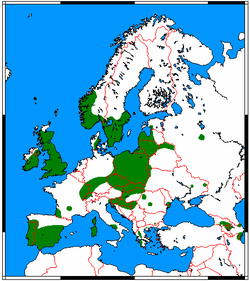 | Size: 3–6 cm (1–2 in), plus 2–4 cm (1–2 in) tail
2–4 cm (1–2 in) forearm length [187]
Habitat: Forest and inland wetlands [216] | LC
Unknown  [216] [216]
|
|---|
| Sturdee's pipistrelle†
| P. sturdeei
Thomas, 1915 | Japan | Size: Unknown length
Habitat: Unknown [217] | EX
0  [217] [217]
|
|---|
| Tiny pipistrelle
| P. nanulus
Thomas, 1904 | Western and central Africa | Size: 3–5 cm (1–2 in), plus 2–4 cm (1–2 in) tail
2–4 cm (1–2 in) forearm length [187]
Habitat: Forest and savanna [218] | LC
Unknown  [218] [218]
|
|---|
| Watts's pipistrelle
| P. wattsi
Kitchener, Caputi, & Jones, 1986 | Papua New Guinea | Size: 3–5 cm (1–2 in), plus 1–3 cm (0.4–1.2 in) tail
2–4 cm (1–2 in) forearm length [187]
Habitat: Forest [219] | LC
Unknown  [219] [219]
|
|---|




